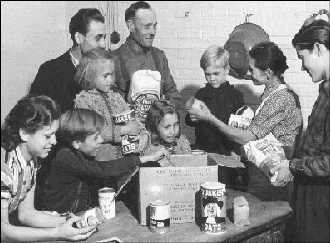
A proud moment for the people of Shelby County, Ohio. This
is how one area resident remembers that hot, steamy July week more than two generations
ago when hundreds of Shelby County neighbors acted together to send food packages to
thousands of German people suffering from the after-effects of Hitler’s war.
It reminded another Shelby County native of the neighborliness of the old-time wheat-threshing days. "We had a job
to do and we did it," World War II veteran John Richards recalls. "Everybody
cooperated. It was a natural and neighborly thing to do. I felt that way and so did
everyone else."
But, "Neighbors in Action," as the local program that summer 50 years ago was
appropriately called, was no wheat threshing or a barn raising. Instead, this was Shelby
County’s unique venture into foreign aid, a countywide effort to invite less
fortunate people, former enemies in fact, to the community dinner table in a spirit of
cooperation, compassion, and forgiveness.
RECOVERING FROM WAR. 1948. Europe still reeled from the devastation of World
War II. The Berlin Airlift was underway to break the Soviet blockade of the two million
Germans isolated in the western sector of that city. The Truman Administration’s
massive program of aid to destroyed European economies --known later as the Marshall
Plan-- was being planned.
In the midst of this international mix of American generosity and political insight,
Shelby County mounted its own effort to relieve hunger and to welcome the German people
back into the international community. An entirely volunteer gesture, Neighbors in Action
extended food and friendship to thousands of Germans hungry for both.
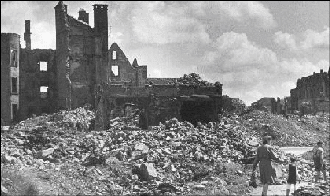
CITED AS INTERNATIONAL EXAMPLE."Friday night (July 23, 1948), 8,000 packages of food
left Sidney bound for Germany to show the people of that war-torn nation that Shelby
countians know of their plight and have done something to help," according to the Sidney Daily News. "Neighbors in Action is a program which top level world
diplomats would do well to consider. Neighborliness and understanding must be in every
peace-making endeavor or the world is doomed to more tragic conflicts."
Neighbors in Action was the idea of Ohio farm organization leader and Turtle Creek
Township farmer Lewis F. Warbington. But, the idea was quickly adopted by the volunteer
efforts of organizations, rural and town, in the county. Both money and labor
contributions quickly materialized from hundreds of Shelby Countians.
At the Sidney courtsquare send-off of the eight semi-trucks laden with 250,000 pounds of food, the appearance of
another volunteer, Ohio Governor Thomas J. Herbert, helped spread the fame of the Shelby
County effort.
Extensive news coverage by the Sidney Daily and Dayton newspapers, and radio
broadcasts throughout Ohio and the nation put the county on the map. The "Three-Star
Extra" coast-to-coast radio newscast featured Neighbors on July 22, the night before
the food started its long journey from Sidney by truck caravan to New York and from there
by ship to Bremerhaven, Germany. Fifteen inches of type detailing the program, written by
a Sidney Daily reporter, was sent over the wires of the International News Service
(like Associated Press) to hundreds of newspapers and radio stations throughout the
country.
At the corporation limit of towns from here to New York, the Neighbors in Action truck
drivers draped huge signs on the side of their vehicles, letting everyone know who was
sending what to where: "Neighbors in Action, 8000 Food Peace Packages for Europe,
Sidney, Shelby County, Ohio."
The journey
continued for 1,000 of the food packages via U.S. military cargo planes bound for Berlin,
making Shelby County a direct participant in the legendary Berlin Airlift. One pilot,
recalls Lew Warbington, Jr., was an Ohio boy "Dad had met at a Farm Bureau meeting
in the thirties. Dad specifically requested that he be the pilot for these Shelby County
food packages." A U.S. Information Service publicity photo showed the Neighbors
in Action sign, just as it earlier dressed the semi-trucks, draped over the plane.
The 8,000 food boxes, each weighing a
little more than 30 pounds, contained flour, sugar, lard, rolled oats, coffee, dried milk,
applesauce, peas, pork and beans, and raisins. "That is not a lot of food when
compared with the diet that our abundance provides for us, but, supplementing the regular
rations that are now being parceled out to the German families and husbanded as they alone
know how to save, it can be expected to make 8,000 families gratefully happy for many
days," according to a Dayton newspaper account. Each box contained one other item, one that
generated many local friendships with German families via international mail: a letter
from the box’s donor in Shelby County. The last person on the Neighbors in Action
food box assembly line in Sidney’s old Slusser-McLean
Scraper Co. building on Canal Street dropped in a letter written in German:
"Dear Friend, We are a group of farmers, merchants, ministers and people of all
walks of life in Shelby County, Ohio, U.S.A., sending you a package of food. Do not accept
this as charity but as a gift from a friend to a friend. After you have received this
package, please sit down and write the donor family about yourself and any other matters
you wish them to know. "Each addressed envelope bore the name of a different
family who had contributed $5 or more toward the project," Warbington, Sr. wrote.
VISIT TO GERMANY SPARKS
NEIGHBORS IDEA. The Neighbors
program occurred to Warbington as he confronted the misery of post-war Germany the
previous summer. He had served on a five-month U.S. Government mission to encourage the
German government and organizations to rebuild the country on democratic principles.
"I was there to deal with farmers, to learn about the problems they faced and to
help them, if possible, by giving them to understand how American farmers might be
inclined to tackle similar problems," Warbington later wrote.
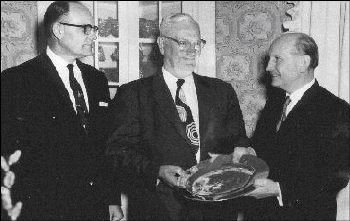
Above: W. H. Van Almsick (right),
consul of the West German Government, presented this silver platter to Warbington in
recognition of Shelby County’s food aid to Germany. "This help saved the lives
of many and enabled the Germans to overcome their worst time in history and find a new
start," Van Almsick said. Sidney city manager Glenn Lovern looks on. Van Almsick told
the guests at the Warbington home that the platter was one of six created by Professor
Ewald Matare of the Academy of Arts in Duesseldorf.
Warbington also visited the Nazi war crime
trials at Nuremberg, witnessing first hand the evil that had come within a hair’s
breadth of destroying Germany. "A sergeant took us to the jail to see the seven
men," he wrote in his memoirs. He saw Admiral Raeder, head of the German Navy
whose U-boats had sent so many allied sailors to watery graves; Admiral Doenitz, successor
to Hitler; Funk, minister of economics who assembled gold fillings from the teeth of
cremated Jews; von Nuerath, foreign minister early in the Third Reich; von Schirach,
Hitler youth leader who taught youngsters to betray their parents; Speer, minister of
armaments and munitions; and Hess, "the six-foot four, heavy-browed he-man who had
flown to England for purposes still argued by people on both sides of the war and who was
now obviously degenerating into madness." Except for Raeder, who "seemed
much pleased with himself," the sullen Third Reich alumni would not talk to
Warbington.
Warbington returned from
Germany with three observations. "First, the German people must have more food now
to prevent starvation...Second, we must see to it that they start to manufacture goods so
they can build up a credit to buy additional food and supplies...Third, the people of
Germany must understand America and know the factors that make a successful democracy."
The evil that
Warbington saw in the Nuremberg jail plus the devastation he observed in Germany’s
streets led him to reflect that "American democracy is based on the principle that
each of us must strive to act as though we are our brother’s keeper...I made up my
mind right there and then on this flying trip (home) that when I got back to my home
base... I should put this proposition up to the members of the Shelby County Farm Bureau
Advisory Council No. Five," the council to which the Warbington family had
belonged since its start in 1936.
Council No. 5. "I give Lewie
a lot of credit for starting Neighbors in Action," Franklin Township farmer Carl
Davidson recently told Jim Sayre. Davidson remains a member of the Farm Bureau council
that first heard Warbington’s proposal 50 years ago. "It was a goodwill
gesture and it let the German people know we were with them. I was there and Council No. 5
was really behind it...100 percent. No question about it," said Davidson who also
worked on the Slusser-McLean assembly line packing the food boxes.
Warbington talked a great deal to his wife
Edna about his idea to help the German people, as his memoirs reveal. "As I
continued to talk to Edna after the children had retired for the night, she finally
interrupted with, ‘Well, I can see we won’t have to worry about what our Farm
Bureau Council is going to discuss when it meets next week -- that is, if you let anyone
else get a word in edgewise.’"
Warbington did, indeed, describe the
conditions in Germany to a number of groups in Shelby County. A 1948 Sidney Daily News photograph shows several Farm Bureau Council No. 5 members attentively listening to him in
county agriculture extension agent Ralph Munger’s home: Harvey Hoewischer, Harry and
Anna Hoewischer, Bill and Betty Hoewischer, Betty Jane Hoewischer, Carl and Ruth Davidson,
Frank and Anna Davidson, and Lyman and Kate Allen.
"Lewie Warbington was a born leader
and an excellent organizer," remembers John Richards, a longtime friend of the
Warbington family and an active participant in the Neighbors project. "After he
explained things to you, I don’t know of anyone who could have turned him down.
"We wondered how our little group
could do something to alleviate the terrible conditions in Europe," Lyman Allen
said later in a radio interview. "We desired to find a way to demonstrate
what could be done by ordinary people. We felt that we should not only feed them in
their desperate need but that we should do it in a truly Christian and neighborly way that
would give us an understanding of each other that might give them hope and help prevent
future wars."
"But,
Neighbors went way beyond our council," Carl Davidson says. "It
soon gained the support of all the Farm Bureau councils in the county, plus the Grange and
many other organizations."
Green Township farmer and county
Grange leader Roger Watkins heard Warbington’s proposal. "The
Granges...agreed to do what they could," Watkins said later. "Then I met
with William Joslin, the county Farm Bureau president. We agreed that the Grange and Farm
Bureau should work together to meet the goal set for the rural areas."
"I was in a pretty good position to work with both organizations,"
says Watkins, then a prominent leader in Farm Bureau and the county’s ten Granges.
Now retired from farming, Watkins and wife Eileen have been Grange members since 1932,
first with New Hope Grange and now Maplewood Grange. "When Warbington came back
from Germany, the picture he portrayed was the need for individual responsibility for this
problem," Watkins said recently.
Lyman Allen, William Joslin, and William Hoewischer formed the committee to contact
other groups. "Representatives from 13 organizations including farm groups,
churches, schools, civic associations, clubs, veterans organizations and villages were
called together," according to Allen. This group selected a campaign chairman, Ralph
Wiessinger, and set up goals for the different groups. They appointed committees for
organizational meetings, publicity, food packaging, and transportation.
The committee set an ambitious goal to solicit money from each of the 7,452 families
then living in Shelby County. Several years later, Kettlersville resident K.P. Schneider,
the first individual to contribute money to the campaign, still held his receipt as a
momento of the Neighbors program. Allen, Joslin, and Hoewischer, all respected farm
businessmen, and Wiessinger, funeral director/owner of the Wiessinger Memorial Home at 324
S. Ohio, were logical choices to bring the rural and urban people of the county together
on the project. "The Wiessinger boys (brother Russell was a Sidney physician) were
very well liked," recalls Russ Sayre, then a Franklin Township farmer who also
helped organize the drive. "Ralph was quite prominent in the Sidney business
community and he helped get Sidney’s cooperation."
Other Neighbors organizers
were Sidney School superintendent Fred Louys, Sidney Civic Association’s Kenneth
McDowell, Perry Township farmer Chuck Collier, and Sidney Methodist minister Dr. Walter
Dickhaut.
Organizations from large to small contributed money to the effort.
Sidney’s Junior Chamber of Commerce gathered $700 in a house-to-house canvass. Boy
Scout troops 188 (Methodist Church) and 92 (Presbyterian Church) raised almost $25, some
of it from the sale of scrap.
Obstacles quickly arose. Some servicemen
were skeptical about helping their recent enemies. But, Warbington wrote later, "To
the credit of the ex-GIs who had fought to defeat the Germans...almost all saw the
foolishness of heaping further suffering on the children of a defeated enemy...opposition
of this kind soon faded away."
But, then the United Fund Drive had just concluded its annual fund-raiser and a "number
of its leaders were determined that there should be only one drive for worthy causes in
our area," Warbington wrote. Their support, when it came, "was not
entirely enthusiastic," he said. Finding money to ship the food was
Warbington’s biggest headache. New York’s United Charities turned a cold
shoulder to his overtures, but a member organization of the group, CRALOG (Council of
Relief Agencies Licensed for Operation in Germany), finally picked up a large part of the
bill.
"Had I known the total amount of difficulty which this idea was destined to
encounter, I might have stopped," Warbington wrote. "But the memory of
the children at Wiesbaden was still so fresh in my mind that I felt opposition could be
removed by an effective explanation."
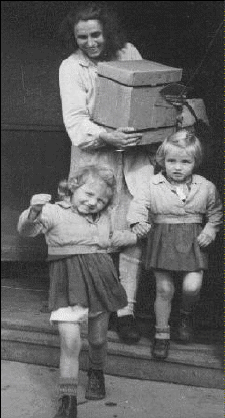
Shelby County
mounted its own foreign aid program in 1948, sending 8,000 food packages to war-devastated
Germany.
This family was overjoyed to receive one of these "Neighbor in Action: food
parcels.
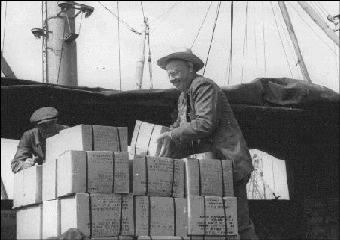
Lewis Warbington is pictured above helping
to unload the Shelby County food parcels from the "Flying Enterprise."
FROM NEW BREMEN TO BREMEN. The 10-pound bags of flour destined for
Germany, by appropriate coincidence, were packaged in New Bremen, Ohio, some of which were
ultimately delivered to Bremen, Germany. "Dad did everything he could to cut costs
so that he could ship more food," Lew, jr. says. "He cut out two or three
middlemen by buying bulk items and getting them processed. He bought grain at Botkins and
had it milled and packaged up at Kuenzel mill in New Bremen. He got the lard rendered in
bulk and then volunteers put it in cans."
Warbington had brought in large drums of
lard from the Braun Brothers Packing Company in Troy and volunteers used them to fill
one-pound cans of lard at the Co-op locker plant in Minster. "I spent one day
canning lard," recalls Ann (Sayre) Fazzini. "My job was to sit on a
little stool in front of the lard machine and fill up the can from a little spigot. I
suppose I set them on a table where someone soldered lids on. Imagine the fuss now days if
a 13-year old were allowed to handle hot lard!"
After a day of canning lard at the Minster locker plant, Richards and Lew, jr. waited
for an hour for Warbington to pick them up. "He didn’t show so we walked
home. It was a long, hot seven miles," recalls Richards.
ASSEMBLY LINE GOES TO WORK. Retired farmer Roger Watkins is quick
to credit Shelby County women for much of the Neighbors work. "I was an active
farmer then, busy in the field, like a lot of other fellows. Women played a heavy part in
assembling those food packages," he says.
Carolyn Dickaut and Johnny Davidson cut the
ribbon, sending the Neighbors in Action trucks on their way. Looking on from left are
Neighbors in Action organizers Lewis Warbington and Ralph Wiessinger, Ohio Supreme Court
Chief Justice Carl V. Weygandt, Ohio Governor Thomas J. Herbert, U.S. Congressman William
McCulloch, and Sidney Daily News editor E.C. Amos.
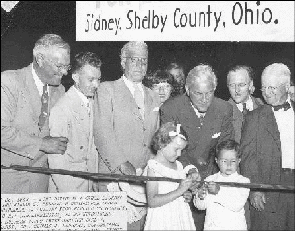
"I spent a couple of days running
an industrial stapling machine to form bottoms of packing boxes, then set them on an
assembly line to be filled by a line of volunteers," recalls Fazzini, then a
13-year old Anna student. "I think the factory was Slusser-McLean, because I
remember walking to Grandma's after I finished. I got volunteered and did the work because
I usually did what I was told and didn’t mind anyway."
Women did in fact dominate newspaper
photographs of the assembly line. While the food was put in place at the assembly line
early in the morning by the men, it was the women who spent the afternoon packing the
boxes. They packed for more than a week, with a new set of about 30 volunteers each day,
according to Lew Warbington, Jr. He and John Richards were the daily exception to the
women-domination rule. They used small tightening contraptions to put two steel straps on
each of the 8,000 packages. "That was a requirement in order to ship them overseas,"
Lew Jr. says.
READY TO SHIP.By July 23, Neighbors in Action was ready to hit the road, the sea, and
the air after 5 months of campaigning and more than a week of packing the boxes. Friday
night, always a busy night on the courtsquare, was even busier as more than 1,000 people
gathered at 8 o’clock on the north side of the courthouse.
Eight trucks from Subler Trucking of Versailles lined the square, the American Legion
band played, local ministers prayed, U.S. Congressman William McCulloch and Sidney Mayor
Waldo Patton made brief remarks, and Governor Herbert "praised the people of
Shelby County for their efforts in making the food enterprise a success."
Chief Justice of the Ohio Supreme Court Carl Weygandt called Neighbors a
symbol of making democracy work. He praised the "kindliness, friendliness and
unselfishness of Shelby countians."
Warbington challenged other communities to "prove that America is more than
money." Remembering some earlier political opposition to the campaign, Warbington
selected two children to cut the ceremonial ribbon. "As far as I could determine,
(they were) without immediate political ambition," Warbington later joked.
The
children, Carolyn Dickhaut, daughter of Sidney’s First United Methodist minister, and
Johnny Davidson, six-year old son of Carl and Ruth Davidson, cut the ribbon, sending the
truck caravan on its way to the New York City wharf where the "Flying
Enterprise" of the Gulbransen Line stood ready to carry the food packages across the
ocean to Bremerhaven.
Warbington, proud of his community, told
people from here to New York City what the people of Shelby County had done. He, Harvey
Hoewischer, and Frank Pfaadt led the trucks to New York in Warbington’s 1948
four-door Pontiac driven by John Richards. He had a loud speaker mounted on the car and
told the "Neighbors story" as they made stops in Columbus, Newark, Coshocton,
Dennison, Cadiz, and Steubenville in Ohio and Pittsburgh, Scranton, Camp Hill, Harrisburg,
and Allentown in Pennsylvania. Lew, jr., then 19 years old, rode in one of the trucks.
"We had a police escort after we went though the tunnel into Manhattan and they
took us to the wharf," Richards remembers. "Lewie met with a bunch of
influential people about the shipping and made final arrangements. Then we went downtown.
Some public relations guy took us country people to the Copacabana nightclub that had a
dinner and show. This was New York nightlife at its best, but I remember the pained
expressions when the check came and Lewie, Uncle Frank, and Harvey had to pay it."
LOCAL FOOD GIFTS
AIRLIFTED TO BERLIN.After the
ship left the dock, Warbington became concerned about whether the boxes would be delivered
to the people who needed them. The personal intervention of General Lucius Clay in Germany
got Warbington free military air passage to Germany to help arrange distribution of the
Shelby County food packages. Seven cities in the western sector of Germany each got about
1,000 packages: Bremen, Kassel, Frankfurt, Wiesbaden, Stuttgart, Munich, and Nuremberg.
The remaining packages became part of the
famous Berlin airlift. Four planes carrying Shelby County food flew into Berlin, one of
them piloted by Capt. Carl Reidelbaugh. He was... "one of the youngsters who had
been in the first Farm Bureau Youth Council I had organized in Van Wert County...several
years before during the Depression when he was a young teenager," said Warbington
who flew into the Soviet-blockaded city to help distribute the packages.
"In each place I urged that the recipients write back to the family whose name
was enclosed in the envelope in the food packages. These people want you to be their
friends," Warbington wrote.
GRATEFUL LETTERS BY THE
THOUSANDS. "It was
quite a big deal," Franklin Township resident Betty Hoewischer remembers. "We
got letters back from the people who got the food." Warbington himself received
more than 3,000 letters.
"The Post Office finally had to stop delivering the letters, there were so
many," recalls Lew Warbington, jr. "Dad would go into Sidney and haul
them home." Lew and Shirley Warbington still hold hundreds of letters, most in
German, that his father and mother received. Lew’s mother Edna, now 102 years old,
still lives in Shelby County. His father died in 1971.
The late Rev. F.
J. Mittermaier, then pastor of Anna’s St. Jacob Lutheran church, alone translated
more than 1,100 letters written by German citizens thanking people in this county for the
gift parcels. Sidney’s Rev. Wobus and many others were busy for more than a month
satisfying the curiosity of our neighbors who had received letters written in German,
according to Warbington.
"Bill and I got ten letters from a German family," recalls Clinton Township resident Dodie Joslin. "We took them to some outfit in
Dayton and paid $10 to have them translated, but we never heard a word from them. And
money was pretty tight then, too," she recalls.
Many Shelby Countians still corresponded regularly with their friends in Germany more
than 20 years after the Neighbors project, according to Warbington. Roger and Eileen
Watkins were among them. "Our Farm Bureau council sent our German families what we
called ‘cheer boxes’ at Christmas time for several years. It was mostly clothing,"
Eileen Watkins says.
Franklin Township farmers Russ and Mary
Louise Sayre also sent clothing and, almost 50 years later, still hold a January 14, 1949,
letter from 19-year old Julius Braun of Frankfurt. He wrote: "The parcel with the
clothing have we got. My sister (Ursula, 15 years old) can wear all and she is very happy
about it. When it is spring I’ll take pictures of her with her dresses and send to
you. My little sister Anneliese (13 years old) is learning Oxford English at her
school."
German resident Lilly Blumler’s August 31, 1948, letter listed the items she
received at her home in Frankfurt: "10 pfund mehl, 5 Pf. Zucker, 2 x Haferflocken,
Erbsen, Bohnen, 1 Dose Milch, 1 Dose Apfelbrei, 1 Pf. Kaffee." A mix-up in the
mail showed Blumler’s yearning for friendship: "Since weeks ago I did not
hear from you anything - perhaps you did not get my last letter. Or are you going to
forget us."
"For all the charity that came out of this package we have to tell you many
thanks," Heinz Grunske of Nuremberg wrote. "That delicious coffee is not
being drunk without thinking of its noble-minded dispenser. It is a real drink of the
Gods. With all my heart I’ve got to say thanks a million and that is not enough
either."
Lessons in democracy were also found
in these letters. "I was rather astonished to hear your husband is a farmer and
you are a high-school teacher," Grunske wrote. "I consider it also for an
expression of the democracy which will hardly win any over here in Germany where the woman
is still fighting for her equalization with the man."
Green Township's Roger and Eileen Watkins review
their 50 year old memories of Neighbors in Action.
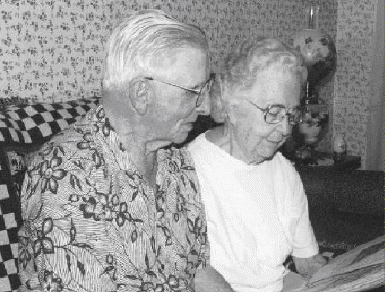
THE REWARD OF
NEIGHBORLINESS. Several years
later, the West German Government presented Warbington with a sterling silver platter
recognizing the Shelby County effort. Lew Warbington, Jr. remembers escorting the West
German consul from Sidney’s Wagner Hotel to the Warbington farm for the presentation.
"The flag of West Germany fluttered on the right front bumper of that long black
limousine. Dad always considered this a proud occasion for the people of Shelby County,"
Warbington says.
"Dankspende des Deutschen Volkes" (Gift of gratitude of the German
nation) is etched on the platter. D.R. Stanfield, then executive secretary of the Ohio
Farm Bureau Federation, said the platter showed "a genuineness of expression of
gratitude and serves as encouragement to the people of the United States."
"This is interesting," Lew Warbington, Jr., says. "Only six
of these German platters were made and just three came to the United States. One went to
the people of Shelby County. One went to former President of the United States Herbert
Hoover for humanitarian aid to Germany, and the third went to an American home
demonstration agent who had taught the German people how to cook with cornmeal."
A Dayton newspaper at the time called the Shelby County program a..."Reenactment
of the age-old parable about a certain man who went down from Jerusalem to Jericho. It
answers again the question, ‘Who is my neighbor?’" Shelby Countians had
no trouble answering that question just 50 years ago this summer. They acted quickly when
they saw the need, simply because it was the neighborly thing to do.
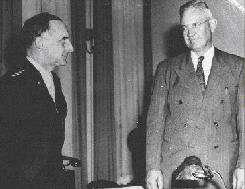
Gen. Lucius Clay,
commander of U.S. occupation forces, personally intervened to allow Warbington to
oversee
distribution of food packages in Germany.
[ Back to War Index ] |

